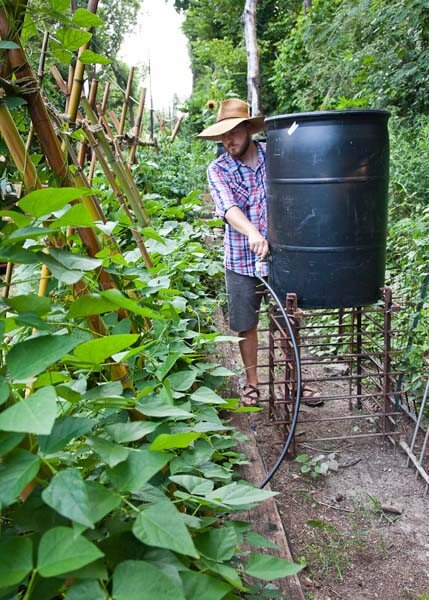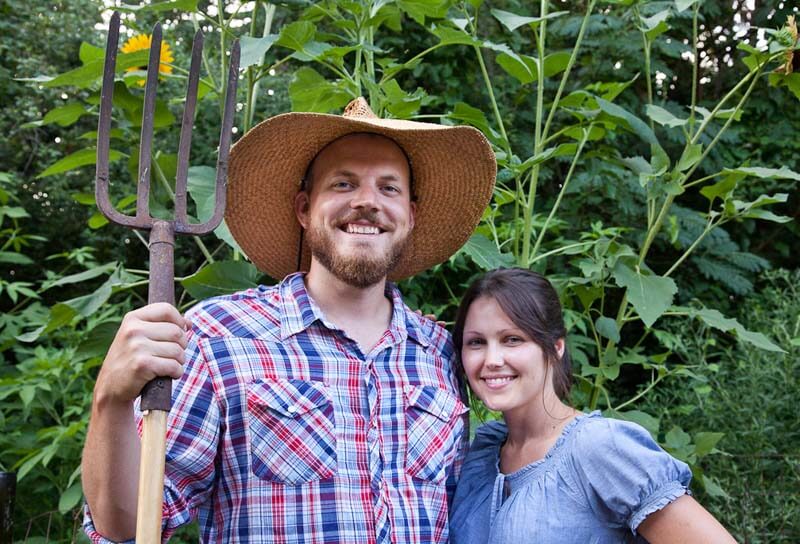Michael Curtis moved into his house in an urban neighborhood in 2006. He'd gardened with his parents while growing up, but the house gave Michael his first opportunity to garden on his own. He took the opportunity and ran with it.

"For three years, I gardened in a small, in-ground garden right outside my back door," he says. Then in 2009, the year Michael married Chasity, he cleared out a 20 by 60 foot brushy space further behind his house and planted a large, traditional rowed garden. "It was huge," he says. "It was cool, but it was too much to handle."
Today, that same 1,200-square-foot space houses a smaller (but sufficient) raised bed garden, a chicken coop, rain barrels, a compost bin, and walking paths. Like many urban gardeners, Michael and Chasity started out with a vision of sustaining themselves from their own small plot of land. While a few urban farmers accomplish this admirable goal, it hasn't proved realistic for these two young professionals with full time jobs. And that's okay.
"My advice for new urban gardeners is don't be overly ambitious," Michael says, but then he recants that statement. "Well, maybe beambitious. If I hadn't been through that experience, I wouldn't understand how to scale appropriately and how that concept
Here is some advice for urban gardeners based on Michael and Chasity's experience.
Build Raised Beds: "Raised beds are nice because I don't have to weed them as much," Michael says. Many urban lots have poor soil. Rather than building up the soil in the ground over time, get started quicker by constructing raised beds and filling them with good quality potting mix, compost, garden soil, or a mixture of the three, like Michael did.
Grow What You'll Eat or Preserve: "The first year, I grew everything: corn, watermelon, cantaloupe. It was overwhelming," Michael says. "Now, I try to think of staples that are easy to grow and easy to manage." In the summer of 2012, Michael and Chasity grew tomatoes, okra, peppers, pole beans, bush beans, cucumbers, and sweet peas. Chasity makes her own soaps, bath salts, and other natural care products using fresh herbs, so they also planted parsley, rosemary, basil, mint, and oregano. They topped off the garden with a long row of sunflowers, just for fun. The couple harvests enough from their garden to eat from it every day in the summer and to preserve produce for the winter. "We freeze a lot of stuff," he says. They still visit their local farmers market most Saturdays to buy the items they don't have the space to grow, such as melons and corn.
Gardening is a Learning Process: "I do a lot of research and reading," Michael says. "But gardening is all about learning from trial and error." He suggests learning one plant at a time. Read up on how to grow something, such as tomatoes, and then try growing a few varieties to see what happens. "Don't be afraid," he says, "gardening is a learning process."
It's Your Garden, So Get Creative: Michael is an architect and builder who also is on a tight budget, so his personal designs focus on recycled and upcycled materials. "The garden is my sanctuary when I'm not working," he says. "It's experimental and inspiring." In his creative urban garden, Michael has used everything from concrete blocks to glass bottles to old windows (for a cold frame) and burglar bars (which elevate his rain barrels). He's even hung old license plates to scare off wildlife—the reflection and clanging noise keeps the birds away. "I'm pretty much a hoarder when it comes to garden stuff," he admits. "There's a freedom in owning your own garden and turning materials into something useful for it."
Use What You Have: As Michael and Chasity's story shows, the trick to urban gardening is making good use of the small space you have. If you only have a patio, plant containers and place them in a sunny spot near a water source. If the only sun your yard gets is in the front yard, plant your veggies and herbs right out front. Rooftop gardens offer a special opportunity. "It only takes one person to start growing in a container on a rooftop," Michael says. You can grow a lot of produce in a few well-planned containers.
Share a Garden: For some urbanites, gardening at home just isn't an option. Look for community gardens in your area where you can either have a personal plot or share the workload and the harvest with a group. If there isn't a community garden nearby, why not start one?
Check Local Laws: Some municipalities have restrictions about practices such as front yard gardening, growing produce for profit, gardening in a right-of-way or easement property, raising chickens, etc. Get to know your local codes before trying any of these popular urban farming ideas.






 Herbs
Herbs
 Vegetables
Vegetables
 Fruit
Fruit
 Flowers
Flowers
 Succulents
Succulents


